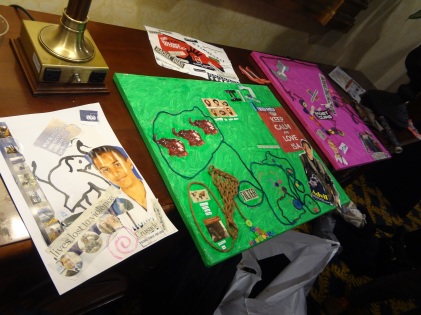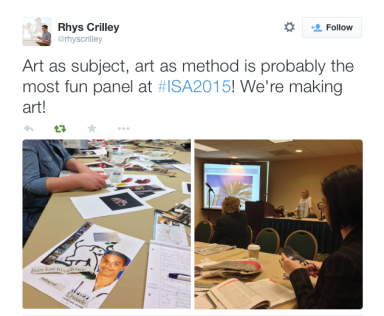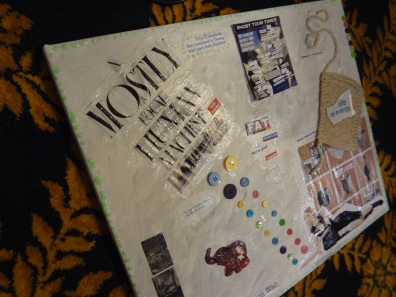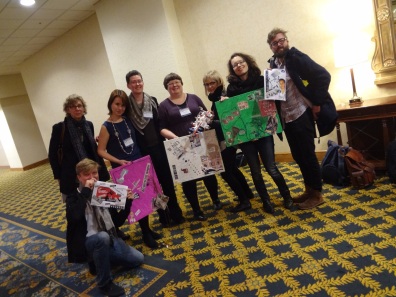Our panel at ISA 2015 began with a comment made in a panel at ISA 2014 in Toronto: “I knit in panels. And this is the first conference I’ve ever attended where I’m the only knitter.” The speaker was Kate Daley, knitting in hand, and the conversations that followed eventually became “Art as Subject, Art as Method”, an innovative panel at this year’s conference in New Orleans.
The role of art in international politics has largely been ignored, a fact which Christine Sylvester has highlighted repeatedly [1]. In our panel, we wanted to combine study of art with the practice of art. Shifting the focus from what we make to the act of making itself, we asked what an engagement with the material, visual, sensory, and creative elements of art and craft could bring to the study of politics, employing not just colour and texture, but also interaction and sensory experience as tools.
Thus, we – along with chair Christine Sylvester and paper presenters Erzsébet Strausz, Leena Kotilainen, Shine Choi, and Kate Daley – decided to convene a panel that would not just talk about art as a method and a methodology for international relations, but would also welcome artistic practice into the conference space itself. Alongside the paper presentations, we invited our audience to participate in collaborative collaging with us in the panel itself, in the Hilton’s Fountain room.
Taking inspiration from our own papers, the Ruby Series, New Orleans, and the ISA itself, we provided materials that ranged from paper cut-outs of elephants, ruby slippers, and hashtags; yarn and knitted scraps; maps of the conference hotels and the city; magazines and journals; book catalogues and event flyers; copies of the New Orleans Times-Picayune; and, of course, colourful buttons and glitter glue. Some attendees contributed their own materials to the collaging, while others brought artistic and creative endeavours of their own. Looking around the room, we saw knitting, photography, drawing, and videography unfolding around us.
The papers we presented brought together wide-ranging themes and ideas that touched on the practice of art in international relations: the ethics of subjective representation and framing in art; the possibilities of auto-photography and a method; the opportunities and challenges of disrupting public spaces with creative practices; the pedagogical usefulness of artistic practice in the classroom; and laughter and playfulness as political potential and subversive resistance.
Our collaging table was never empty, as audience members circulated from their seats to the cutting area to the three canvases, prepared with ground colours of white, green, and hot pink. (In fact, at certain moments the space could hardly accommodate those wanting to take part, and we had to work to make room and give way to new arrivals.) The resulting collages are an eclectic and ad hoc mix of styles, colours, images, shapes, textures, and words. The panel also gave rise to a number of smaller collages, drawings, and sculptures – some collaborative and some the result of individual inspiration. Some of the pieces display clear narratives and themes, while others play with colour and graphic design, and still others pull together seemingly disparate elements into a whole.
As scholars, it is important to ask ourselves what we might be able to accomplish as artists, artisans, and crafters, or what we might encounter in doing and making, in opening up the conventional scholarly practices of discussing, reading, and writing to a radically practice-oriented view and allowing for the emergence of new, experimental forms of academic production. Many of us work with visual material as research material, yet we rarely produce visuals (beyond PowerPoint presentations) individually let alone collectively. The panel presentations introduced some visual methodologies and art as subject of research.
Creating a space, in the middle of an academic conference, where scholars can do and make stuff proved to be fun and freeing for many. A chance to breathe freely and let go of some of the usual pressures felt at ISA. As such, this kind of experiment can be seen as a radical space for self care in a quite unhealthy and high-pressure environment, and its potential as a feminist act should certainly not be overlooked. When we ask ourselves what we learned from “Art as Subject, Art as Method”, we’re left with a few scattered thoughts and reflections:
Thinking differently when hands are busy: It often seems that we tend to forget that scholars, too, are embodied beings. We have learned through our years in the discipline that, in a conference setting, it is ‘natural’ to sit still and listen to others talk. An appropriate form of ‘doing’ in a conference space is to take notes, and the correct form of interaction with others is to ask questions at the end of the session. This panel gave us the opportunity to question the ‘naturalness’ of these conventions and introduce new forms of engagement, presence, and attention into the panel space. Activities like knitting may sometimes be seen as disruptive or rude while listening to papers, even if it does not make a sound and may help the one knitting to concentrate better on what is being said. It is not something we are used to seeing in professional academic spaces. This is also a gendered dynamic: women especially can struggle to be taken seriously [2], and doing things that are traditionally associated with femininity in professional spaces can be risky. Creating something tangible, whether that be doodles, collages, bobble hats, or time-lapse photography, can focus the mind and bring to light connections that might otherwise be missed.
Connecting with others – starting conversations: In spite of – or perhaps because of – the risks, doing something unexpected can inspire new conversations and cooperative efforts. This panel was itself the result of a conversation that began because of creative practice in a professional space. As an ethical practice, creative collaboration can be a form of self-care, radical openness, and interactivity, expanding and repurposing the conference space for its participants. Collaborative art can also be an important methodological innovation for our research, helping us to connect with and learn from the subjects of our research in new ways, as Leena’s presentation showed so well.
Questions of ownership of collective creative endeavours: In the panel, we noticed that one of our audience members spent quite a long time with a particular canvas, lovingly designing and gluing on pieces of the collage. Later, in the discussion that followed the paper presentations, this audience member remarked on how difficult it was to move away and let someone else continue ‘her’ collage. She was anxious and curious to see what became of the canvas once other people had taken over in her place. What does this anecdote tell us about the nature of academic work and authorship? We have to own our work, and we cannot control what others will do with it – but we are not usually presented so immediately and concretely with the directions in which others may take our work. Could this kind of anxiety over ownership prevent us from doing more collaborative work? Usually the rationale for preferring individually authored work is seen as a structural issue (in the academic economy we get more ‘points’ for individual than collective work), but shouldn’t we also pay attention to the affective reasons?
Laughter and playfulness: What do we gain when academic spaces are constructed as serious, formal, and carefully structured? More importantly, though, what do we lose? Shine’s paper in particular showed the radical potential of humour and light-heartedness. Given that conference panels are an affective space that is usually characterized by formality, structure, and nervousness – and sometimes by tension and combativeness – we tried to counter this with a relaxed, playful and informal atmosphere. As we recall here, serious issues do indeed arise and can be discussed fruitfully even in more informal and playful settings. These kind of spaces feed creativity and can give rise to new insights on the deadly serious issues of IR. As Elina Penttinen argues [3] we should be mindful of how and what we put out into the world in our academic practice. Do we choose to produce more competition and anxiety – or more joy, laughter, and companionship?
Open-endedness and uncertainty: Undertaken in this way – in the moment, without planning or prescribed goals – we found that collective artistic practice provided an opportunity to think about uncertainty. We didn’t know at the beginning of the panel whether people would embrace our idea, or whether we would sit alone at the collaging table. We also could not have predicted how the collages themselves would take shape. It was fascinating to see what unexpected uses our materials found, what combinatory artworks our efforts created, and what new directions our conversations took over the course of the panel.
When we planned this panel, we did not know what this space would become. We wanted to do instead of just talking, and we knew we wanted the space be something different than the usual panels at ISA. In the end, we were left with more questions than answers. These questions point us to important issues, not only regarding art-making and crafting but also about academic conferencing and IR itself. What kinds of creative practices are possible in public, professional, intellectual spaces? What stories, perspectives, voices, or insights can we share and express through art that we can’t through traditional forms of researching, teaching, writing, or knowing?
We hope that “Art as Subject, Art as Method” will be just the beginning and that future conferences in IR will see more and more varied answers to the questions above. For our part, we certainly plan to push for more creativity, more spontaneity, more openness, and more glitter glue at the ISA.
This piece was co-authored by Saara Särmä, who recently completed an amazing doctoral thesis at the University of Tampere called Junk Feminism and Nuclear Wannabes, and whose methodology of collage was a partial inspiration for this innovative panel. Her artwork can be found at http://www.huippumisukka.fi
[1] See Sylvester, Christine (2013) ‘The Elusive Arts of Reflexivity in the “Sciences” of IR,’ Millennium: Journal of International Studies, 41(2): 209-225; (2009) Art/Museums: International Relations Where We Least Expect It, Boulder, Paradigm Publishers; (2007) ‘Whither the International at the End of IR’, Millennium: Journal of International Studies 35(3): 551-573.
[2] Enloe, Cynthia (2013) Seriously! Investigating Crashes and Crises as if Women Mattered, Berkley, University of California Press.
[3] Penttinen, Elina (2013) Joy and International Relations: A New Methodology, London, Routledge.




Reblogged this on oshriradhekrishnabole.
LikeLike
Reblogged this on oshriradhekrishnabole.
LikeLike